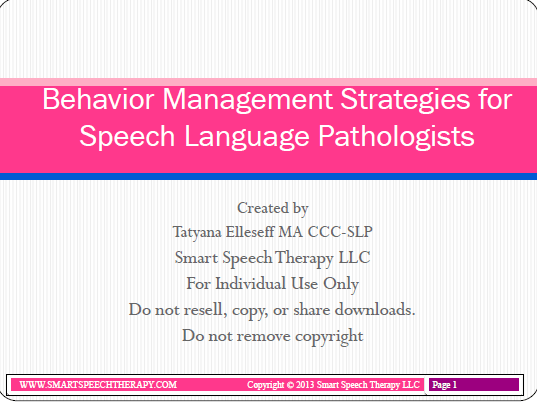Sign Up For Our E-Blast To Receive Information on our Books, Speech Therapy materials and our latest freebies!
Review: Behavior Management Strategies for Speech Language Pathologists by Smart Speech Therapy
Review: Behavior Management Strategies for Speech Language Pathologists
product reviewed by moi, Kim Scanlon
Ever have a child on your caseload and think, “Gee, I could really use some behavior management strategies to make these sessions more effective?” Well, if you need to learn a few new tricks or just want a refresher, the presentation, “Behavior Management Strategies for Speech Language Pathologists”, by Tayana Elleseff of Smart Speech Therapy, is a great resource.

What will I learn from “Behavior Management Strategies for Speech Language Pathologists”?
According to Smart Speech Therapy, this presentation will teach the reader the following objectives:
• Common behavior patterns in various types of clients, including those with genetic, psychiatric, and neurological disorders
• How to use behavior management strategies in a hierarchal fashion for students of all different types of abilities
• How to use positive proactive strategies to prevent inappropriate behaviors from occurring
Since I’ve been in the speech therapy field for a few years, I’m privy to some of the more common behavior management techniques. However, I wasn’t too familiar with Functional Behavior Analysis (FBA) and learned a good amount on data collection. So, I believe that readers will also learn about how to properly assess and collect data before implementing a treatment program.
Who is this presentation for?
Even though Tatyana targets her presentation to speech language pathologists (SLPs), I believe other professionals such as educators, psychologists, social workers, occupational and physical therapists, etc. would also benefit. Since the information is presented in a straightforward and simple manner, I argue that a parent of a child with challenging behavior, possibly with one of the following disorders, would also learn from it:
• Autistic Spectrum Disorders (including Asperger’s)
• Nonverbal Learning Disability
• Mental Retardation: (Genetic, Neurological, Acquired)
• Down Syndrome, Fragile X, CHARGE, Prader-Willi
• Injuries at Birth, Infections, Iodine Deficiency
• Encephalitis, Meningitis, Fetal Alcohol Spectrum Disorder
• Psychiatric Disorders (e.g. Mood Disorders; Anxiety
• Disorders, ODD, ADHD, etc)
• Traumatic Brain Injury (frontal lobe)
• Severe Communication Impairment
What’s included in this presentation?
A lot of helpful information! Including some of the following:
- Ideas and Suggestions for Assessment and Treatment
- Numerous examples of Antecedents, Behaviors, Functional Behavioral Analysis “Write Ups”, and Consequences
- How to Prioritize Treatment
- Behavior Management Hierarchy
- Types of Effective Behavior Management Strategies (this is one of my favorite sections!)
- Maintaining Factors that may further impact treatment (Cognitive, Sensorimotor, Psychosocial, Linguistic)
- 10 Ways to Modify a Child’s Behavior (e.g. errorless learning and 80/20 rule)
- How to Teach Replacement Behaviors
- Types of Praise
- 5 Case Examples to Target the Following Behaviors (love this section too!)
- Immature Behaviors
- Noncompliance
- Aggressive Tantrum
- Excessive Talking/Topic Perseveration
- Severe Inattention and Impulsivity
What I like about “Behavior Management Strategies for Speech Language Pathologists”?
• Since it’s a PowerPoint presentation, much of the information is presented in bullet points. So, processing the information is quick and easy to read. It’s not like reading a dense textbook.
• Helps you trouble shoot the potential causes to your client or student’s challenging behaviors by assisting you in carefully considering his or her needs. Tatyana does a nice job of explaining why you need to systematically identify specific antecedents or triggers BEFORE designing intervention.
o I particularly like that she includes an extensive example list of possible antecedents. This was helpful because it made me reflect about my own clients and facilitated brainstorming of other possible antecedents.
• Explains how to collect data and prioritize intervention to properly design your treatment plan.
• Gives numerous examples on how to compose various Functional Behavior Analysis (FBA) “write-ups”. I’ll give you one example to give you an idea:
o “When Michael is asked to wait in line (antecedent), he attempts to run away (behavior), to escape waiting (function).”
o I LOVE examples because they encourage learning and strengthen understanding. Tatyana included several examples to demonstrate most of the strategies and modifications.
• As I mentioned before, one of my favorite sections is on Types of Effective Behavior Management Strategies. These ranged from physical space modifications to session structure modifications to session materials modifications. Once again, she went into detail. I LOVE that I learned about a super cool seat modification to reduce hyperactivity and impulsivity.
• I also enjoyed learning some of lingo associated with FBA. Now, I know how to label and distinguish pivot praise from specific praise!
• Lastly, the 5 case examples were also instructive because it assisted me in reflecting back about some of my own clients and students.
Overall, Behavior Management Strategies for Speech Language Pathologists gets a thumbs up!
Click here to visit Smart Speech Therapy’s store.
I hope this review was helpful!
Kimberly Scanlon, M.A. CCC-SLP is a speech language pathologist, an author and a mother. As the owner of Scanlon Speech Therapy, LLC, a unique boutique practice in Bergen County, Kimberly embraces individuality and treats the whole person. Her goal is to spread compassion, hope, and some speech, language and literacy tips one moment, one person at a time. Her first book, My Toddler Talks: Strategies and Activities to Promote Your Child’s Language Development and her her second book, Learning to Read is a Ball
are available for purchase at online at Amazon and Barnes and Noble.
